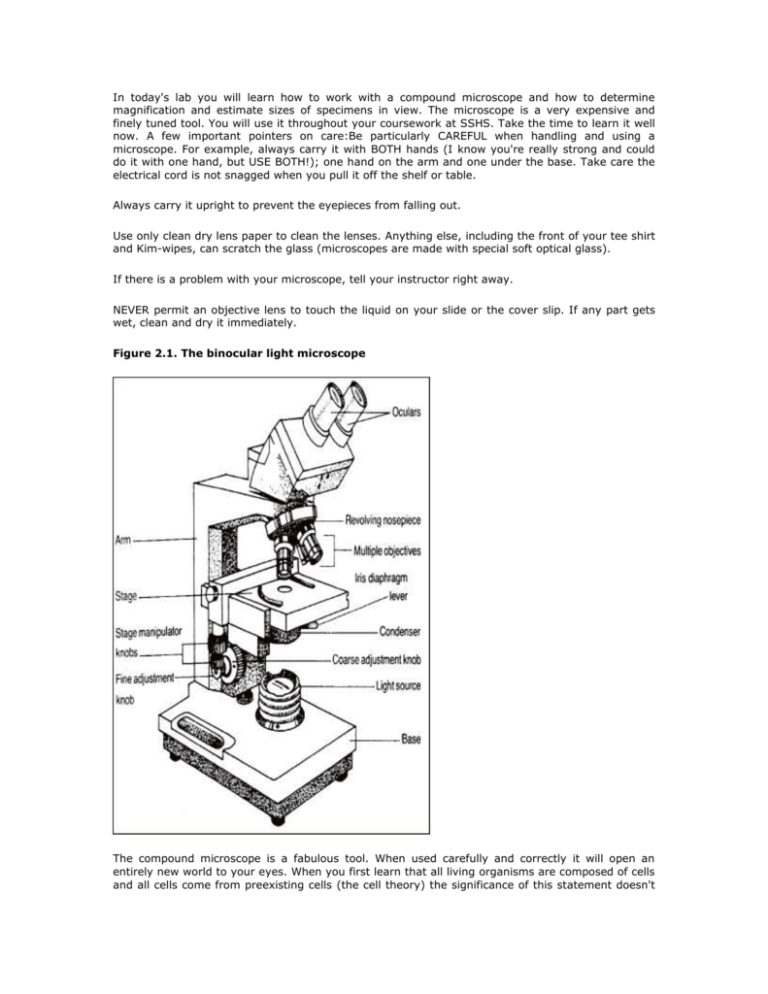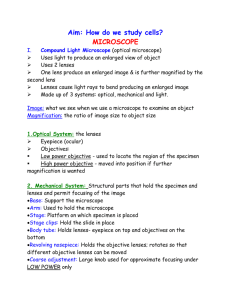In today's lab you will learn how to work with a compound
advertisement

In today's lab you will learn how to work with a compound microscope and how to determine magnification and estimate sizes of specimens in view. The microscope is a very expensive and finely tuned tool. You will use it throughout your coursework at SSHS. Take the time to learn it well now. A few important pointers on care:Be particularly CAREFUL when handling and using a microscope. For example, always carry it with BOTH hands (I know you're really strong and could do it with one hand, but USE BOTH!); one hand on the arm and one under the base. Take care the electrical cord is not snagged when you pull it off the shelf or table. Always carry it upright to prevent the eyepieces from falling out. Use only clean dry lens paper to clean the lenses. Anything else, including the front of your tee shirt and Kim-wipes, can scratch the glass (microscopes are made with special soft optical glass). If there is a problem with your microscope, tell your instructor right away. NEVER permit an objective lens to touch the liquid on your slide or the cover slip. If any part gets wet, clean and dry it immediately. Figure 2.1. The binocular light microscope The compound microscope is a fabulous tool. When used carefully and correctly it will open an entirely new world to your eyes. When you first learn that all living organisms are composed of cells and all cells come from preexisting cells (the cell theory) the significance of this statement doesn't really sink in. Not until you use a microscope to view microscopic creatures and examine bits and pieces of living organisms do you begin to appreciate all the similarities, and all the differences between organisms. The light microscope is a coordinated system of lenses arranged to produce a magnified, focusable image of a specimen. Magnification is usually accompanied by improved resolution, the ability to distinguish two points as separate points. The resolving power of a light microscope is dependent on both the magnification and quality of the lenses. The unaided human eye can distinguish two points approximately 0.1 mm apart. A good quality light microscope can resolve about 500x better (two points 0.2 mm apart!). The ability to discern detail also depends on contrast. Many specimens are stained with dyes to increase contrast and make the specimen more visible. Light microscopes have two systems: an illuminating system and an imaging system. The illuminating system concentrates light on the specimen. It usually consists of a light source, condenser lens, and iris diaphragm. The light source is a light bulb at the base of the microscope. The condenser lens, immediately below the specimen focuses the light on the specimen. Just below the condenser is an iris diaphragm that may be opened and closed with a lever to regulate the amount of light reaching the specimen. When the iris diaphragm is open, the image is brightest; when closed it will be dim. On the microscopes used to capture images (record make and model in your notebook) there is a phase contrast dial, a more sophisticated device for optimizing the illuminating system. You will appreciate this when viewing protists in pond water! With phase-contrast viewing, the transmitted light beams enter the specimen out of phase with one another (phase-contrast). Phase-contrast is used when you are viewing a clear specimen that you do not wish to stain (staining may affect its activity or in some cases, may kill it). With phase-contrast, denser parts of the specimen appear dark and less dense areas appear more clear. Thus, you are able to see structures within cells, such as nuclei and eye spots, that may be invisible with brightfield microscopy. A special dial below the stage allows you to alter the light beam passing through the specimen so that the light waves are out of phase. Your instructor will demonstrate how to manipulate the condenser to achieve phasecontrast. The phase contrast dial has a condenser turret which can be rotated to specific light annulus settings dependent upon the chosen objective magnification. It also has an iris diaphragm lever that should be left in the fully opened position for use with phase-contrast. There is a light adjustment dial (red) on the left side of the microscope base to provide variable light intensity to the specimen. The imaging system improves resolution and magnifies the image. It consists of an ocular (eyepiece) lens and objective lenses. Your Leica microscopes are binocular. They have an interpupillary distance adjustment to adjust the binocular eyepiece to fit the eyes of the individual user. The objective lenses are mounted on a revolving nosepiece that is rotated to swing the chosen objective into the light path. Each objective is actually a series of several lenses that magnify the image, improve resolution, and correct aberrations in the image. The magnifying power is etched on the side of the lens. See below for total resolution of the Leica microscopes. In most cases we will not use the 100x oil immersion objective lens.






